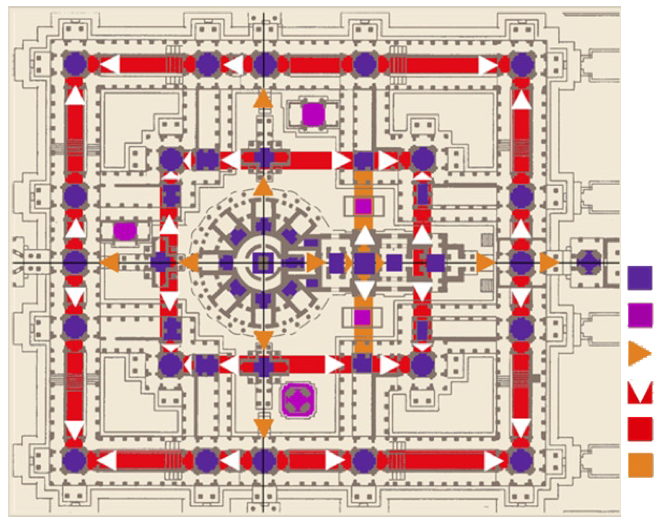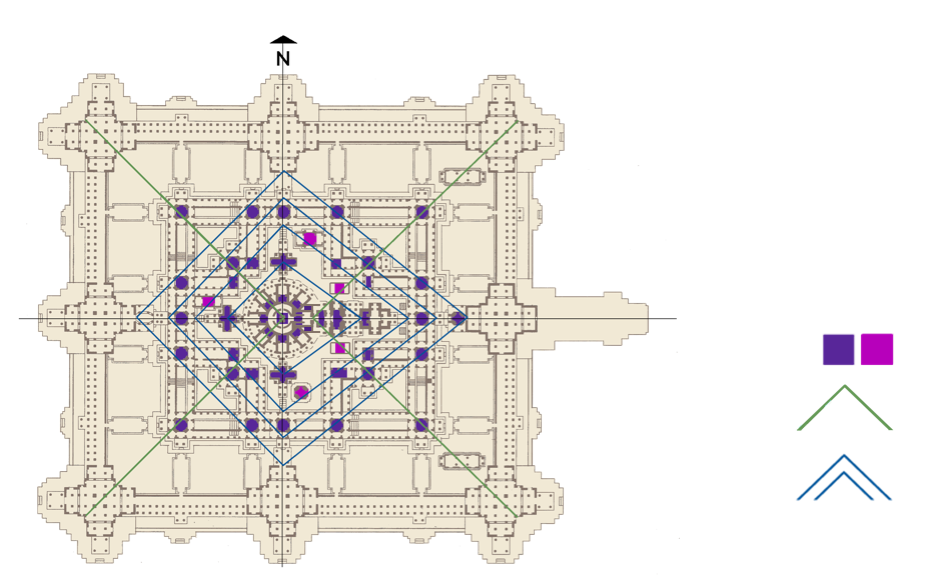The Enigma of the Face Towers’
Orthogonal, Diagonal and Circular Geometries

FIGURE 23A: ANALYSIS OF AXIAL AND LATERAL PROJECTION OF THE FACE TOWERS, BAYON (1181-1220)
Face towers (52?)
“Anomalous” or “irregular” face towers (5)
Axial projection of each face tower
Lateral projection of each face tower
Outlines of 2 concentric rectangles with 16 towers each
East side of central square with 14 towers
The Bayon’s celebrated face towers (shaded purple and mauve in figure 23 A) pose larger enigmas – not least their identity – but also why they were arranged the way they were with some seemingly sprinkled at random across the temple’s terraces. Thirty-seven face towers remain of an original forty-nine to fifty-four and more than 125 “faces” are still visible. There is no consensus on the total number, primarily, because the upper levels of the central shikhara are too deteriorated to determine how many it may have held and because the 1st gallery has been almost entirely destroyed except for the wall with the celebrated bas reliefs. The source used for figures 26A, 26B and 26C estimates fifty-two original towers and results from a recent, independent survey of the site. Other scholars have speculated that each tower was oriented towards a different province of the Khmer Empire, although the number of towers and provinces clearly altered over Jayavarman VII’s reign. The majority of the face towers appear to have been positioned or generated through the same process of “cruciform expansion,” that is axial projection and lateral branching, illustrated by the Baphuon (see figure 20.)
In figure 23A, axial projection is indicated by orange arrows and lateral by white arrows on red bars. 1) The towers’ replication begins with the projection of the original four sub-shrines or porches from the single square cella or sanctuary. 2) Each of these then emanates one cruciform tower on the north, west and south arms of the cruciform 3rd terrace, at the midpoint between the axial crossing and the outer edge of the colonnade of the 2nd gallery and terrace. 3) These towers again axially project the middle towers of the triple gopuras of the 2nd gallery. (There would have been a fourth axial projection if, as some scholars believe, there were face towers over the 1st terrace’s, four, large, single gopuras. Unfortunately, these were cannibalized as quarries for later building projects, including the nearby Spean Thma bridge between Thommanon and Ta Keo.)
Each of the medial towers are laterally projected twice in both directions. 4) The first lateral projection places eight towers parallel with the outer entrances of the triple gopuras of the 2nd gallery. 5) The second lateral projection places four "shared" towers at the corners where these projections intersect. The two lateral projections form a rectangle (red band) with sixteen face towers (five on each side, with four overlapping or "shared" at the corners.) The second, axially projected towers, the middle towers of the north, south and west triple gopuras of the 2nd gallery, also replicate themselves twice laterally in both directions. 6) The first eight towers form the two outer towers of the four triple gopuras. 7) The second become the four corner towers of the rectangular (outer) 2nd gallery and terrace. The second two lateral projections form a concentric rectangle (red band) also with sixteen towers which surrounds the inner rectangle. This rectangle contains the nine central padas of the underlying upapitha 5x5 pada mandala. Sixteen is also the number of rectangular and triangular shrines radiating around the sanctuary, as well as of the now-destroyed Buddhist shrines linking the 2nd and 1st galleries. Together the two rectangles contain thirty-two face towers, the number of bodhisattvas emanated from the five dhyani or tathagata Buddhas in a Diamond World Mandala.
The five face towers to the east are equidistant from the north-south axis as the five to the west which form the western edge of the inner rectangle: (a) the outside two are the first towers axially projected to the east on the inner rectangle; (b) the middle tower is the third projected to the east along the east-west axis; (c) this tower, in turn laterally projects the two "anomalous" face towers flanking the east-west axis, making five. These form a square around the circular central shrine consisting of fourteen face towers, thus integrating the asymmetrical, rectangular, east side of the Bayon with the “ideal,” four-way symmetry of its west. At Angkor Wat, the 3rd terrace also forms a square, also achieved by the insertion of two segments, labelled b on the second diagram on page 27. The Bayon achieves the same result with its first asymmetrical insert (12a in figure 22,) which increases the distance of the first laterally projected tower to the east on the inner rectangle, so it equals that of the second laterally projected tower to the west. (The second insert, 12b in figure 22, makes the inner and outer rectangles of sixteen face towers concentric.) By this hypothetical count, the “original” face towers of the Bayon may have included, as shown in figure 23A: 1) one directly above the cella; 2) eight above each of its sub-shrines or porches; 3) two (mauve) flanking the east-west axis on the east of the 3rd terrace; 4) two flanking the “double”antechamber to the cella; 5) three more over the other enclosed chambers to its east; 6) one over the inner porch of the eastern gopura of the 1st gallery; 7) sixteen along the rectangular (outer) 2nd gallery; 8) sixteen along the inner rectangle of face towers on the 3rd terrace; 9) finally, three “anomalous” towers (mauve,) two on the east side of the broadened north-south transept of the 3rd terrace and one inserted into its western arm: fifty-two in all – give or take a few.
The face towers are also positioned along four concentric diamonds (blue lines,) some on their lines, others within their vertices, others tangent to them; the diamonds are elongated on the east by the two westward inserts or 7.3% off-set, similar to the “virtual terraces” and sub-shrines at Preah Khan. Moving from the outside to the center: 1) the first diamond connects the inside edges of the four porches of the single gopuras of the 1st gallery and terrace; 2) the second, the outer edges of the 2nd gallery outer colonnade where it intersects the cardinal axes; 3) the third, the inner edges of the 2nd gallery’s colonnade where it intersects those axes; (this coincides with the edges of the 3rd terrace;) 4) the fourth, the centers of the free-standing, north, west and south medial towers on the 3rd terrace and, on the east, the fourth axially projected tower. Three of the towers usually designated as “anomalous,” “irregular” or “capricious” because outside the two concentric rectangles of towers in figure 23A, all fall on the third set of diagonals, those linking the inside edges of the 2nd gallery; this might account for where they are placed but not why.
In addition, four diagonals (olive lines) drawn from the northwest and southwest corners of the 1st gallery and terrace to the center of the sanctuary (the axial crossing) and from its northeast and southeast corners to a point equidistant along the east-west axis (at the front of the second tower axially projected to the east:) 1) are separated by the width of the 7.3% westward off-set (12a + b in figure 22;) 2) pass through, on the west, (a) the two face towers above the intercardinal shrines of the shikhara and (b, c) the four western corners of the two concentric rectangles of face towers (red bands in figure 23A;) 3) and, on the east, (a) the two, "irregular," axially-flanking towers (mauve) on the 3rd terrace and (b) the four eastern corner towers of the two concentric rectangles of face towers; 4) the four diagonals (olive lines) also outline an irregular triple panchyatana or quincunx with two foci and hence 14 not 13 face towers: the 12 face towers (2a and b and 3a and b above) plus the two foci, the central tower and second axially projected face tower to the east.
FIGURE 23B:
ANALYSIS OF DIAGONALS POSITIONING THE FACE TOWERS, BAYON (1181-1220)
Regular and irregular face towers (52)
Diagonals positioning triple quincunx of face towers (4)
Concentric diamonds positioning face towers (4)
Regular and irregular face towers (52)
Diagonals positioning triple quincunx of face towers (4)
Concentric diamonds positioning face towers (4)
